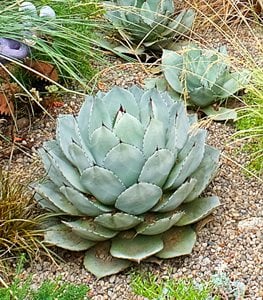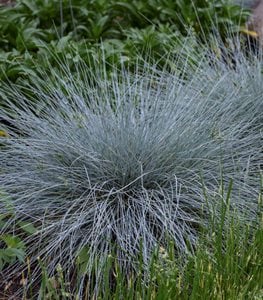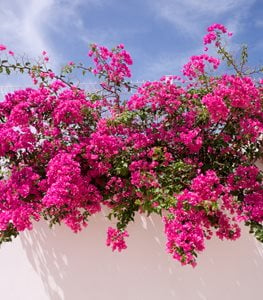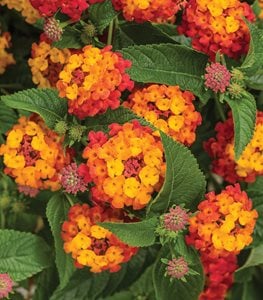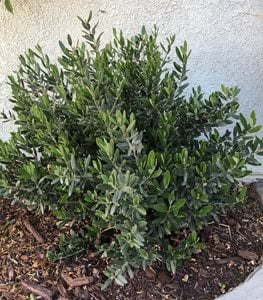20+ Mediterranean Plants for Your Garden
Use these drought tolerant, low-maintenance plants in a Mediterranean-style landscape Published 10/7/2022With many areas becoming drier due to climate change, growing drought-tolerant plants has become a necessity. Many of these dry border plants originate in the Mediterranean region, which experiences hot dry summers and mild wet winters.
Some plants commonly grown in the Mediterranean region such as bougainvillea and pelargonium have come from other similar climates such as South Africa, Australia, South America, and California. They are often referred to as Mediterranean plants even though they originate from other places. These plants are valued for attributes including color, structure, texture, fragrance, and resilience. Whether they are true Mediterranean natives or embraced by gardeners in that region, here are some of the best plants to grow in a Mediterranean-style garden.
AGAVE (Agave spp.)
Zones: 5-12
Exposure: Full sun
Habit: Upright and clumping habit
Height/Spread: 1 to 10 feet tall and wide, with flower spikes up to 30 feet tall
Bloom time: Blooms once before dying; bloom time varies according to species
Agave is a spiky evergreen succulent distinguished by fleshy pointed leaves with sharp spines at the leaf tips and sometimes along the edges. Foliage is green, blue, or silver-grey, some with yellow or cream variegation. Agave adds bold symmetrical structure to beds, borders, and containers. Use as a dramatic focal point in the landscape. Learn more about growing agave plants.
ARTEMISIA (Artemisia spp.)
Zones: 3-10
Exposure: Full sun
Habit: Upright mounding or spreading habit
Height/Spread: 1 to 6 feet tall, 1 to 12 feet wide
Bloom time: Summer to fall
Grown for the finely dissected aromatic foliage in colors of silver, white, or grey, artemisia adds subdued color and soft texture to beds, borders, and containers. This bushy herbaceous perennial is useful as a background element, complementing many other dry border plants. Tolerant of heat, drought, and poor soils. Learn more about growing artemisia plants.
BLUE FESCUE (Festuca glauca)
Zones: 4-8
Exposure: Full sun
Habit: Mounding clumping habit
Height/Spread: 6 to 12 inches tall, 6 to 18 inches wide
Bloom time: Summer
Silvery-blue evergreen foliage is complemented by wheat-colored flower heads that appear in summer. This dwarf ornamental grass adds fine texture to the landscape, complementing many other summer bloomers including salvia, yarrow, and santolina. Useful in mass plantings, containers, and small spaces.
BOUGAINVILLEA (Bougainvillea spp.)
Zones: 9-11
Exposure: Full sun
Habit: Vining spreading habit
Height/Spread: 20 to 30 feet tall, 8 to 10 feet wide
Bloom time: Summer in cooler climates, nearly year-round in warmer regions
Bougainvillea is a staple of Mediterranean gardens, producing flowers in shades of pink, magenta, red, purple, orange, or white. This vining evergreen shrub provides long-lasting color when grown as shade cover for a pergola, on a sturdy wall trellis, as a ground cover, or in containers. In colder climates, plants can be grown as annuals or overwintered indoors. Learn more about growing bougainvillea.
CATMINT (Nepeta spp.)
Zones: 3-9
Exposure: Full sun to partial shade
Habit: Bushy spreading habit
Height/Spread: 1 to 3 feet tall and wide
Bloom time: Late spring to fall
This mint relative produces clusters of blue flowers on aromatic gray-green foliage. Catmint is tolerant of a wide range of growing conditions and soils. Grow this long-blooming herbaceous perennial in beds, borders, containers, and curbside strips. Makes a good substitute for lavender in colder regions. Learn more about growing catmint plants.
ZONAL GERANIUM (Pelargonium spp.)
Zones: 9-12
Exposure: Full sun to light shade
Habit: Upright bushy habit
Height/Spread: 1 to 3 feet tall, 1 to 2 feet wide
Bloom time: Mid-spring through frost
Grown as a popular bedding plant, this tender perennial is commonly used in Mediterranean landscapes. Plant in containers, window boxes, hanging baskets, or mass in beds and borders. May be overwintered indoors in colder climates. Learn more about growing zonal geraniums.
GLOBE THISTLE (Echinops bannaticus)
Zones: 3-9
Exposure: Full sun
Habit: Upright branching habit
Height/Spread: 2 to 4 feet tall, 1 to 3 feet wide
Bloom time: Summer
Spiky globe-shaped flowers add structural interest to beds and borders. Flower color is bright blue, violet-blue, or silver-gray, while the deeply dissected thistle-like foliage is green or silver-gray. Combines well with many other summer-blooming perennials including Russian sage (Perovskia), torch lily (Kniphofia) and coneflower (Echinacea).
ITALIAN CYPRESS (Cupressus sempervirens)
Zones: 7-11
Exposure: Full sun
Habit: Narrow columnar habit
Height/Spread: 40 to 70 feet tall, 3 to 20 feet wide
Bloom time: Spring
Italian cypress is a commonly used evergreen conifer in the Mediterranean region, grown for the narrow, tapered habit that lends vertical height and structure in the landscape. To get the look of Italian cypress in cooler, wetter climates and smaller yards, substitute other evergreens with a similar shape such as ‘Skyrocket’ juniper, ‘Emerald Green’ arborvitae or ‘Sky Pencil’ holly.
COMMON JASMINE (Jasminum officinale)
Zones: 7-10
Exposure: Full sun to partial shade
Habit: Vining spreading habit
Height/Spread: 15 to 30 feet tall, 7 to 15 feet wide
Bloom time: Late spring to frost
Common jasmine is a semi-evergreen or deciduous climbing shrub grown for the intensely fragrant star-shaped white flowers. Grow on a pergola to provide shade, on a trellis along a wall, as a ground cover, or in containers. In colder climates, jasmine can be overwintered indoors or substituted for a hardier fragrant vine such as honeysuckle.
JERUSALEM SAGE (Phlomis spp.)
Zones: 5-11, depending on the species
Exposure: Full sun to partial shade
Habit: Upright spreading habit
Height/Spread: 1 to 4 feet tall, 1 to 6 feet wide
Bloom time: Spring to summer
Native to the Mediterranean region, Jerusalem sage produces unique whorls of yellow, lavender, or pink tubular flowers. This shrubby evergreen perennial, related to mint, has fuzzy gray-green leaves and is adaptable to most soil types. Combine with asters, ornamental grasses, salvia, and catmint.
LAMB'S EAR (Stachys byzantina)
Zones: 4-9
Exposure: Full sun to partial shade
Habit: Mounding spreading habit
Height/Spread: 6 to 18 inches tall, 12 to 36 inches wide
Bloom time: Summer
This Mediterranean native is a dense mat-forming perennial grown for the velvety silver foliage that resembles lamb’s ears. Spikes of tiny pink flowers appear in summer. Use as a ground cover, as edging along a pathway, or at the front of a mixed border. Learn more about growing lamb's ear.
LANTANA (Lantana camara)
Zones: 9-11
Exposure: Full sun
Habit: Compact bushy habit
Height/Spread: 2 to 6 feet tall when grown as a perennial in warmer regions. In colder areas where grown as an annual, lantana can reach 3 to 4 feet tall and 1 to 3 feet wide in a single season.
Bloom time: Nearly year-round in frost-free regions; late spring through frost in colder climates
Lantana is commonly grown in Mediterranean landscapes, producing clusters of tiny open-faced flowers in tropical hues of pink, orange, yellow, purple, coral, red, and white. This tender perennial shrub blooms throughout the growing season, with flowers that are attractive to butterflies and other insect pollinators. In colder climates, lantana can be grown in containers and overwintered indoors. Learn more about how to grow lantana.
LAVENDER (Lavandula spp.)
Zones: 5-9
Exposure: Full sun
Habit: Bushy spreading habit
Height/Spread: 1 to 4 feet tall, 1 to 5 feet wide
Bloom time: Late spring to fall
This popular Mediterranean native is grown for the scented flowers and foliage with a variety of ornamental, culinary, and medicinal uses. Spiky clusters of tiny flowers occur in shades of lavender, purple, pink, yellow, and white above dissected gray-green foliage. Use this shrubby perennial herb in beds, borders, and containers. Learn more about how to grow lavender.
LILY OF THE NILE (Agapanthus spp.)
Zones: 7-11; some varieties can survive to Zones 5-6 with heavy winter mulch
Exposure: Full sun to partial shade
Habit: Upright spreading habit
Height/Spread: 1-1/2 to 4 feet tall, 1 to 2 feet wide
Bloom time: Mid-summer to early fall
Rounded clusters of star-shaped flowers occur in shades of blue, purple, or white on stately stems. Strappy foliage is green or variegated. This South African native grows and spreads through fleshy rhizomes. Use to fill gaps in a mixed border, mass in beds, or plant in containers. Learn more about how to grow agapanthus.
LITTLE OLLIE® DWARF OLIVE TREE (Olea europaea 'Montra')
Zones: 8-11
Exposure: Full sun
Habit: Compact bushy habit
Height/Spread: 4 to 6 feet tall and wide
Bloom time: Spring; blooms are inconspicuous
Get the look of a traditional Mediterranean olive tree without the fruit or large size. Willow-like dark green foliage with a silvery-green underside adds soft color and texture to the landscape. This dwarf broadleaf evergreen is multi-stemmed and can be sheared as formal hedging, used as a stand-alone focal point, or trained into a specimen or topiary. Learn more about how to grow olive trees.
ROCK ROSE PLANT (Cistus spp.)
Zones: 7-11
Exposure: Full sun
Habit: Mounding bushy habit
Height/Spread: 1 to 6 feet tall, 1 to 8 feet wide
Bloom time: Late spring to early fall
Rock rose has green or variegated foliage and attractive five-petaled flowers in colors of pink, magenta, or white, some with eye-catching patterns. Though individual flowers may last just a day or so, this tough evergreen shrub blooms over an exceptionally long time. Use in waterwise strips, mass plantings, rock gardens, or as a ground cover. Protect from harsh winds and heavy frost.
ROSEMARY (Salvia rosmarinus)
Zones: 8-11
Exposure: Full sun
Habit: Bushy spreading habit
Height/Spread: 2 to 6 feet tall, 2 to 5 feet wide
Bloom time: Late winter to spring, with sporadic rebloom
Rosemary is an aromatic shrubby herb that is commonly used in Mediterranean cuisine. Needle-like silvery-green leaves are produced on upright woody stems, with clusters of soft blue or white flowers appearing in late winter and spring. Plant in an herb garden, waterwise strip, or as hedging. Smaller specimens can be kept in a pot and overwintered indoors. Learn more about how to grow rosemary.
'CARADONNA' SAGE (Salvia nemorosa)
Zones: 4-9
Exposure: Full sun
Habit: Upright clumping habit
Height/Spread: 1 to 2 feet tall and wide
Bloom time: Late spring through summer
There are hundreds of different ornamental and culinary sages, which are ideal for Mediterranean landscapes. ‘Caradonna’ sage is a hardy variety that produces striking deep-purple flower spikes over an exceptionally long time. Keep flowers deadheaded for extended bloom. Plant in a perennial or mixed border, cottage garden, or container. Learn more about growing salvia plants.
MEDITERRANEAN SPURGE (Euphorbia characias subsp. wulfenii)
Zones: 6-10
Exposure: Full sun to partial shade
Habit: Upright bushy habit
Height/Spread: 2 to 4 feet tall, 1 to 4 feet wide
Bloom time: Spring to early summer
This evergreen subshrub produces long-lasting chartreuse flower bracts on erect woody stems. The unusual blooms are complemented by narrow blue-green leaves that grow along the entire length of the stems. Use in a mixed border, rock garden, or as a striking focal point. Avoid coming into direct contact with the milky sap. Learn more about growing euphorbia plants.
WINDMILL PALM (Trachycarpus fortunei)
Zones: 7-11
Exposure: Full sun to partial shade
Habit: Upright habit
Height/Spread: 8 to 10 feet tall, 4 to 6 feet wide; up to 25 feet tall in warmer regions
Bloom time: Summer
Palms are a common feature in Mediterranean gardens, lending a tropical feel to the landscape. Windmill palm is one of the hardiest, with attractive fan-shaped fronds produced on a fibrous brown trunk. Mature trees produce yellow flowers that give way to dark-blue fruits. This striking evergreen palm adds year-round structure to beds and borders. Use as a focal point or plant smaller specimens in containers. May need winter protection in colder areas.
ADDITIONAL PLANTS FOR MEDITERRANEAN GARDENS
| ORNAMENTAL TREES | Bay tree (Laurus nobilis), cork oak (Quercus suber), Crape myrtle (Lagerstroemia indica), Jacaranda (Jacaranda mimosifolia), strawberry tree (Arbutus unedo) |
| FRUIT TREES | Fig, lemon, loquat, orange, pomegranate, quince |
| SHRUBS | Bottlebrush (Callistemon), California lilac (Ceanothus), oleander, plumbago, silverberry (Elaeagnus ebbingei), Spanish broom (Genista hispanica) |
| PERENNIALS | Bearded iris, Santolina lavender cotton, kniphofia, Mexican bush sage (Salvia leucantha), Pride of Madeira (Echium candicans), sea holly (Eryngium), yarrow, California poppy |
| VINES | Grape, honeysuckle, passionflower, trumpet vine, wisteria |
| CACTI AND SUCCULENTS | Echeveria, hens and chicks, portulaca, rock purslane (Calandrinia), sedum, yucca. Cold hardy cacti include prickly pear (Opuntia), hedgehog cactus (Echinocereus), barrel cactus (Echinocactus). In wetter climates, provide protection from excessive rainfall. |
| HERBS | Chives, marjoram, mint, oregano, parsley, sage, tarragon, thyme |
| BULBS | Allium, crocus, cyclamen, fritillaria, grape hyacinth (Muscari), lady tulip (Tulipa clusiana), Sicilian honey garlic (Nectaroscordum siculum), winter aconite (Eranthis hyemalis) |
| ANNUALS | Butter daisy (Melampodium), cosmos, globe amaranth, marigold, morning glory, sunflower, zinnia |
| SILVER FOLIAGE* |
Dusty miller (Senecio cineraria), licorice plant (Helichrysum petiolare) Russian sage (Perovskia), rose campion (Silene coronaria, syn. Lychnis coronaria), snow-in-summer (Cerastium tomentosum) |
*Plants with silver foliage are commonly used in the Mediterranean region, as the lighter color reflects the sun’s heat and helps plants to conserve water, making them more adaptable to hot, dry climates.


